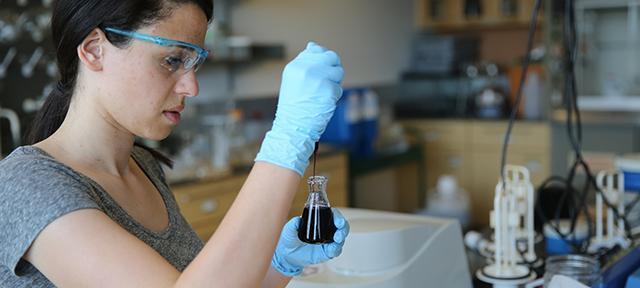Mimi Alkattan: Researching Sustainable Water-Treatment Alternatives

Division III project: Water Resource Engineering at the Edges: Application of Drinking Water Resource Engineering and Research in Low-Income and High-Income Communities
Faculty Advisers: Professor Christina Cianfrani, Professor Elizabeth Conlisk, Kaoru Ikuma, assistant professor at Iowa State University
Academic Intersections: Natural Science and Critical Social Inquiry
"Sixty percent of the water projects in the developing world fail. I’ve done two projects in Kenya with Engineers Without Borders, in January 2014 and January 2015, and the outcomes were night and day. One didn’t work and one was wildly successful. It was interesting to me because they were done back to back, by the same group in the same community.
For my Division III research I explored drinking-water resources in developed and developing countries. The first section was a case study on rural water development in Kenya. For the second part of my project, I did research through the Environmental and Water Resources Engineering Labs at UMass Amherst on disinfection by-products, figuring how to see what’s in the water, and treatment.
We looked at Philadelphia, which discharges its treated wastewater back into the Delaware River. That’s also where the people get their drinking water. It’s just a cycle of discharge and uptake, and it may be a window into what the future will be like for developing countries. We’re not going to be seeing pristine water sources, so water will have to be disinfected.
When you add chlorine to water, it disinfects it but also creates harmful by-products. The benefits generally outweigh the costs. But studies on water resources are finding a class of man-made iodine compounds, called iodinated x-ray contrast media (ICM), that’s coming mainly from hospitals. ICMs, when they break down, are much more toxic than are disinfection by-products from chlorine. They’re geneotoxic, which means they attack DNA.
The treatment I decided to use was ferrate(VI), a form of iron that’s a very strong oxidant. It removed ICMs more significantly than did any other method. A lot of people claim it’s an earth-friendly green treatment. I don’t know why it’s so different, why it’s so special. We need to know the effects of it to determine if it’s useful as part of a tiered treatment system, and the ongoing research is making progress toward that.
This spring I was accepted into the Peace Corps to work on water sanitation and hygiene in Mali. After the Peace Corps, I plan to get a PhD in water-resource engineering and focus on public health. I’m interested in education, too, and some of the outreach aspects of being a scientist and an engineer. I take pictures of my research so people can be more connected to the work we do. By publicizing it, I hope people, especially youths, can better understand the research and see how important it is to their daily lives."
Kaoru Ikuma on Mimi's research: "Using ferrate in drinking water is a relatively new approach. There’s potential for it, but we don’t yet have the information needed to back up its effectiveness. Mimi’s work pushed that understanding to see how useful it is in getting rid of pharmaceuticals we don’t want. She’s contributing to our understanding of a potentially sustainable water-treatment option, and one that applies to developing areas. That’s what really drove Mimi to want to research ferrate. We got most of the data we needed, but now it just needs some more in-depth analysis before we publish the results. It’s exciting when an undergraduate follows through with an entire project. From seeing Mimi in the lab, I knew how reliable she was. I’ve worked with many undergraduates and junior graduate students, and it’s rare to see her kind of ability."



